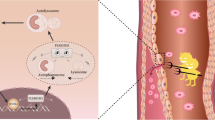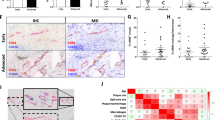Abstract
Purpose
Recent emergence of miRNAs as important regulators of processes involving lesion formation and regression has highlighted miRNAs as potent therapeutic targets for the treatment of atherosclerosis. Few studies have reported the atheroprotective role of IL-35, a novel immunosuppressive and anti-inflammatory cytokine; however, miRNA-dependent regulation underlying the anti-atherosclerotic potential of IL-35 remains elusive.
Methods
THP-1 macrophages were incubated with human recombinant IL-35 (rIL-35) either in the presence or absence of ox-LDL. qRT-PCR was conducted to validate the expression levels of previously identified miRNAs including miR-197-5p, miR-4442, miR-324-3p, miR-6879-5p, and miR-6069 that were differentially expressed in peripheral blood mononuclear cells of coronary artery disease (CAD) patients vs. controls. Additionally, bioinformatic analysis was performed to predict miRNA-associated targets and their corresponding functional significance in CAD.
Results
Exogenous IL-35 significantly decreased the average area of ox-LDL-stimulated macrophages, indicating the inhibitory effect of IL-35 on lipid-laden foam cell formation. Furthermore, rIL-35 treatment alleviated the ox-LDL-mediated atherogenic effects by modulating the expression levels of aforementioned CAD-associated miRNAs in the cultured macrophages. Moreover, functional enrichment analysis of these miRNA-related targets revealed their role in the molecular processes affecting different stages of atheroslerotic plaque development, such as macrophage polarization, T cell suppression, lipoprotein metabolism, foam cell formation, and iNOS-mediated inflammation.
Conclusion
Our observations uncover the novel role of IL-35 as an epigenetic modifier as it influences the expression level of miRNAs implicated in the pathogenesis of atherosclerosis. Thus, IL-35 cytokine therapy–mediated miRNA targeting could be an effective therapeutic strategy against the development of early atheromas in asymptomatic high-risk CAD patients.











Similar content being viewed by others
Availability of Data and Materials
The data used to support the findings of this study are included within the article.
Abbreviations
- rIL-35:
-
Recombinant interleukin-35
- miRNA:
-
MicroRNA
- Ox-LDL:
-
Oxidized low-density lipoprotein
- CAD:
-
Coronary artery disease
- PBMCs:
-
Peripheral blood mononuclear cells
- VSMC:
-
Vascular smooth muscle cell
- EC:
-
Endothelial cell
- Treg:
-
Regulatory T cells
References
Rafieian-Kopaei M, Setorki M, Doudi M, Baradaran A, Nasri H. Atherosclerosis: process, indicators, risk factors and new hopes. Int J Prev Med. 2014;5(8):927–46.
Mohmmad-Rezaei M, Arefnezhad R, Ahmadi R, Abdollahpour-Alitappeh M, Mirzaei Y, Arjmand MH, et al. An overview of the innate and adaptive immune system in atherosclerosis. IUBMB Life. 2021;73(1):64–91.
Fatkhullina AR, Peshkova IO, Koltsova EK. The role of cytokines in the development of atherosclerosis. Biochemistry (Mosc). 2016;81(11):1358–70.
Egwuagu CE, Yu CR, Sun L, Wang R. Interleukin 35: critical regulator of immunity and lymphocyte-mediated diseases. Cytokine Growth Factor Rev. 2015;26(5):587–93.
Huang Y, Lin YZ, Shi Y, Ji QW. IL-35: a potential target for the treatment of atherosclerosis. Pharmazie. 2013;68(10):793–5.
Li X, Shao Y, Sha X, Fang P, Kuo YM, Andrews AJ, et al. IL-35 (Interleukin-35) suppresses endothelial cell activation by inhibiting mitochondrial reactive oxygen species-mediated site-specific acetylation of H3K14 (histone 3 lysine 14). Arterioscler Thromb Vasc Biol. 2018;38(3):599–609.
Lin Y, Huang Y, Lu Z, Luo C, Shi Y, Zeng Q, et al. Decreased plasma IL-35 levels are related to the left ventricular ejection fraction in coronary artery diseases. PLoS One. 2012;7(12):e52490.
Tao L, Zhu J, Chen Y, Wang Q, Pan Y, Yu Q, et al. IL-35 improves Treg-mediated immune suppression in atherosclerotic mice. Exp Ther Med. 2016;12(4):2469–76.
Andreou I, Sun X, Stone PH, Edelman ER, Feinberg MW. miRNAs in atherosclerotic plaque initiation, progression, and rupture. Trends Mol Med. 2015;21(5):307–18.
Zhong Z, Hou J, Zhang Q, Zhong W, Li B, Li C, Liu Z, Yang M, Zhao P. Circulating microRNA expression profiling and bioinformatics analysis of dysregulated microRNAs of patients with coronary artery disease. Medicine (Baltimore). 2018;97(27):e11428.
Sawant DV, Hamilton K, Vignali DA. Interleukin-35: Expanding Its Job Profile. J Interferon Cytokine Res. 2015;35(7):499–512.
Ito TK, Yokoyama M, Yoshida Y, Nojima A, Kassai H, Oishi K, et al. A crucial role for CDC42 in senescence-associated inflammation and atherosclerosis. PLoS One. 2014;9(7):e102186.
Lin J, Kakkar V, Lu X. The role of interleukin 35 in atherosclerosis. Curr Pharm Des. 2015;21(35):5151–9.
Brophy ML, Dong Y, Wu H, Rahman HN, Song K, Chen H. Eating the dead to keep atherosclerosis at bay. Front Cardiovasc Med. 2017;30(4):2.
Schulte C, Molz S, Appelbaum S, Karakas M, Ojeda F, Lau DM, et al. miRNA-197 and miRNA-223 predict cardiovascular death in a cohort of patients with symptomatic coronary artery disease. PLoS One. 2015;10(12):e0145930.
Liu W, Zheng J, Dong J, Bai R, Song D, Ma X, et al. Association of miR-197-5p, a circulating biomarker for heart failure, with myocardial fibrosis and adverse cardiovascular events among patients with stage C or D heart failure. Cardiology. 2018;141(4):212–25.
Lin P, Ji HH, Li YJ, Guo SD. Macrophage plasticity and atherosclerosis therapy. Front Mol Biosci. 2021;8:679797.
Yang S, Yuan HQ, Hao YM, Ren Z, Qu SL, Liu LS, et al. Macrophage polarization in atherosclerosis. Clin Chim Acta. 2020;501:142–6.
Zhou D, Yang K, Chen L, Zhang W, Xu Z, Zuo J, et al. Promising landscape for regulating macrophage polarization: epigenetic viewpoint. Oncotarget. 2017;8(34):57693–706.
Qin H, Holdbrooks AT, Liu Y, Reynolds SL, Yanagisawa LL, Benveniste EN. SOCS3 deficiency promotes M1 macrophage polarization and inflammation. J Immunol. 2012;189(7):3439–48.
He C, Carter AB. The metabolic prospective and redox regulation of macrophage polarization. J Clin Cell Immunol. 2015;6(6):371.
El Chartouni C, Schwarzfischer L, Rehli M. Interleukin-4 induced interferon regulatory factor (Irf) 4 participates in the regulation of alternative macrophage priming. Immunobiology. 2010;215(9–10):821–5.
Lund RJ, Chen Z, Scheinin J, Lahesmaa R. Early target genes of IL-12 and STAT4 signaling in th cells. J Immunol. 2004;172(11):6775–82.
Amento EP, Ehsani N, Palmer H, Libby P. Cytokines and growth factors positively and negatively regulate interstitial collagen gene expression in human vascular smooth muscle cells. Arterioscler Thromb. 1991;11(5):1223–30.
Autieri MV. Pro- and anti-inflammatory cytokine networks in atherosclerosis. ISRN Vasc Med. 2012;2012:1–17.
Xia F, Qian CR, Xun Z, Hamon Y, Sartre AM, Formisano A, et al. TCR and CD28 concomitant stimulation elicits a distinctive calcium response in naive T cells. Front Immunol. 2018;9:2864.
de Boer OJ, Hirsch F, van der Wal AC, van der Loos CM, Das PK, Becker AE. Costimulatory molecules in human atherosclerotic plaques: an indication of antigen specific T lymphocyte activation. Atherosclerosis. 1997;133(2):227–34.
Alegre ML, Frauwirth KA, Thompson CB. T-cell regulation by CD28 and CTLA-4. Nat Rev Immunol. 2001;1(3):220–8.
Sakaguchi S, Yamaguchi T, Nomura T, Ono M. Regulatory T cells and immune tolerance. Cell. 2008;133(5):775–87.
Linton MRF, Yancey PG, Davies SS, et al. The role of lipids and lipoproteins in atherosclerosis. 2019 Jan 3. In: Feingold KR, Anawalt B, Boyce A, et al., editors. Endotext. South Dartmouth: MDText.com, Inc.; 2000.
Abd El-Aziz TA, Mohamed RH. LDLR, ApoB and ApoE genes polymorphisms and classical risk factors in premature coronary artery disease. Gene. 2016;590(2):263–9.
Oppi S, Lüscher TF, Stein S. Mouse models for atherosclerosis research—which is my line? Front Cardiovasc Med. 2019;6:46.
Xu J, Chen Z, Wang Y, Wang X, Chen L, Yuan T, et al. Several circulating miRNAs related to hyperlipidemia and atherosclerotic cardiovascular diseases. Lipids Health Dis. 2019;18(1):104.
Zhang PD, Liu YF, Guo Y, Miao F, Yu ZG, Wang SX. Oxidized low-density lipoprotein enhances the expressions of SREBP-2 and HMGCR mRNA in macrophages derived from the monocytes of patients with acute coronary syndrome. Nan Fang Yi Ke Da Xue Xue Bao. 2009;29(5):929–32.
Giunzioni I, Tavori H, Covarrubias R, Major AS, Ding L, Zhang Y, et al. Local effects of human PCSK9 on the atherosclerotic lesion. J Pathol. 2016;238(1):52–62.
Cui CJ, Li S, Li JJ. PCSK9 and its modulation. Clin Chim Acta. 2015;440:79–86.
Luquero A, Badimon L, Borrell-Pages M. PCSK9 Functions in atherosclerosis are not limited to plasmatic LDL-cholesterol regulation. Front Cardiovasc Med. 2021;8:639727.
Plakkal Ayyappan J, Paul A, Goo YH. Lipid droplet-associated proteins in atherosclerosis (Review). Mol Med Rep. 2016;13(6):4527–34.
Pirillo A, Norata GD, Catapano AL. LOX-1, OxLDL, and atherosclerosis. Mediators Inflamm. 2013;2013:152786.
Gliozzi M, Scicchitano M, Bosco F, Musolino V, Carresi C, Scarano F, et al. Modulation of nitric oxide synthases by oxidized LDLs: role in vascular inflammation and atherosclerosis development. Int J Mol Sci. 2019;20(13):3294.
Kawashima S, Yokoyama M. Dysfunction of endothelial nitric oxide synthase and atherosclerosis. Arterioscler Thromb Vasc Biol. 2004;24(6):998–1005.
Lakin ND, Jackson SP. Regulation of p53 in response to DNA damage. Oncogene. 1999;18(53):7644–55.
Giovannini C, Varì R, Scazzocchio B, Sanchez M, Santangelo C, Filesi C, et al. OxLDL induced p53-dependent apoptosis by activating p38MAPK and PKCδ signaling pathways in J774A.1 macrophage cells. J Mol Cell Biol. 2011;3(5):316–8.
Yuan XM, Osman E, Miah S, Zadeh SN, Xu L, Forssell C, et al. p53 expression in human carotid atheroma is significantly related to plaque instability and clinical manifestations. Atherosclerosis. 2010;210(2):392–9.
Chen C, Wang Y, Yang S, Li H, Zhao G, Wang F, et al. MiR-320a contributes to atherogenesis by augmenting multiple risk factors and down-regulating SRF. J Cell Mol Med. 2015;19(5):970–85.
Spiering D, Hodgson L. Dynamics of the Rho-family small GTPases in actin regulation and motility. Cell Adh Migr. 2011;5(2):170–80.
Marei H, Malliri A. Rac1 in human diseases: The therapeutic potential of targeting Rac1 signaling regulatory mechanisms. Small GTPases. 2017;8(3):139–63.
Bandaru S, Ala C, Ekstrand M, Akula MK, Pedrelli M, Liu X, et al. Lack of RAC1 in macrophages protects against atherosclerosis. PLoS One. 2020;15(9):e0239284.
Acknowledgements
We would like to acknowledge Mrs. Sakshi Mehta for providing her help in the basic cell culture work.
Author information
Authors and Affiliations
Contributions
SB made intellectual contributions to the analysis of data, interpretation of the results, writing of the manuscript, and designing of figures. AKY collected the data and performed the experiments with CB. AKY performed the bioinformatics analysis with inputs from SB. CB made contributions to the conception and design of the work. VD supervised the project.
Corresponding author
Ethics declarations
Ethical Approval and Consent to Participate
Not applicable.
Consent for Publication
Not applicable.
Conflict of Interest
The authors declare no competing interests.
Additional information
Publisher's Note
Springer Nature remains neutral with regard to jurisdictional claims in published maps and institutional affiliations.
Rights and permissions
Springer Nature or its licensor holds exclusive rights to this article under a publishing agreement with the author(s) or other rightsholder(s); author self-archiving of the accepted manuscript version of this article is solely governed by the terms of such publishing agreement and applicable law.
About this article
Cite this article
Bhansali, S., Yadav, A.K., Bakshi, C. et al. Interleukin-35 Mitigates ox-LDL-Induced Proatherogenic Effects via Modulating miRNAs Associated with Coronary Artery Disease (CAD). Cardiovasc Drugs Ther 37, 667–682 (2023). https://doi.org/10.1007/s10557-022-07335-x
Accepted:
Published:
Issue Date:
DOI: https://doi.org/10.1007/s10557-022-07335-x




